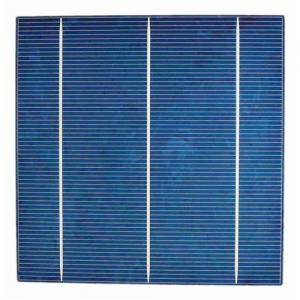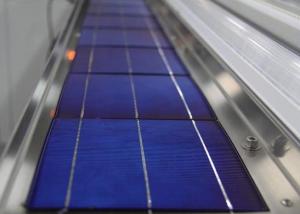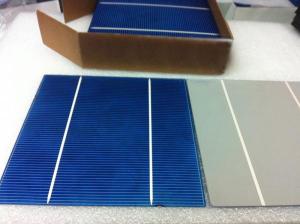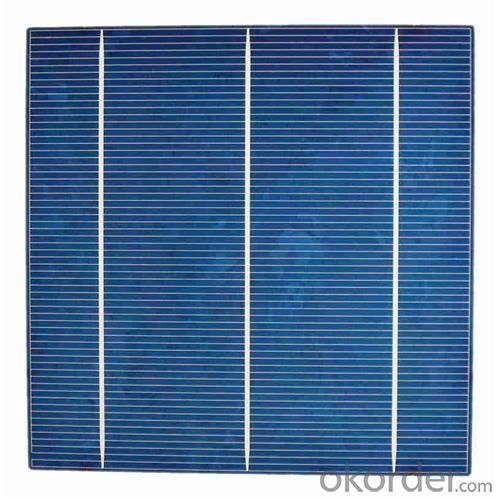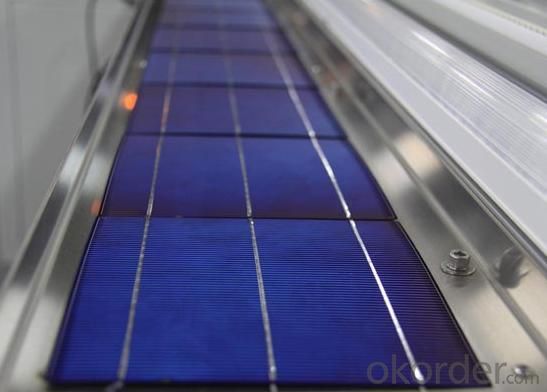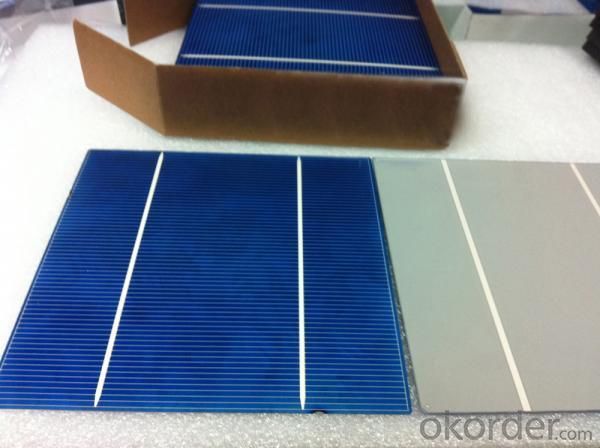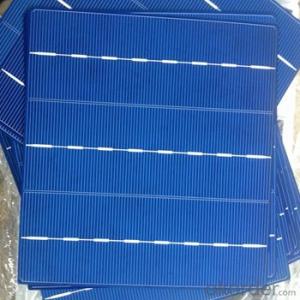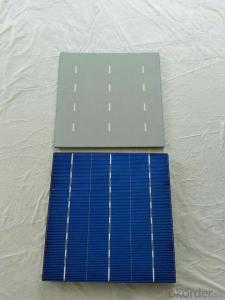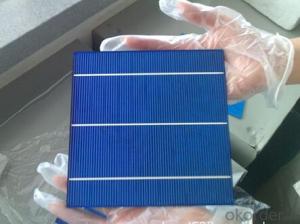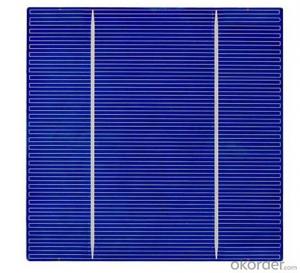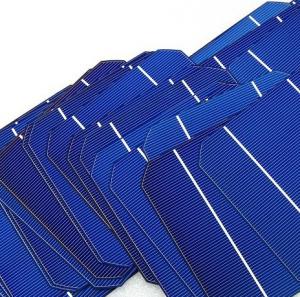Polycrystalline Solar Cells 2BB/3BB with Long-term Electrical Stability
- Loading Port:
- Tianjin
- Payment Terms:
- TT or LC
- Min Order Qty:
- 4200 watt
- Supply Capability:
- 600000 watt/month
OKorder Service Pledge
OKorder Financial Service
You Might Also Like
Specifications of Poly Solar Cells
Format | 156 mm × 156 mm ± 0.5 mm |
Thickness- | 210μm ± 40 μm |
Front (-) | 1.5mm bus bars (silver),blue anti-reflection coating (silicon nitride) |
Back (+) | 2.5mm wide soldering pads (silver) back surface field (aluminium) |
Temperature Coefficient of Poly Cells
Voc.Temp .coef.%/K | -0.351%/K |
| Isc.Temp .coef.%/K | +0.035%/K |
| Pm.Temp. coef.%/K | -0.47%/K |
Electrical Characteristic of Poly Cells
Efficiency | Efficiency | Pmax(W) | Average | Impp(A) | Vmpp(V) | Isc(A) | Voc(V) |
1720 | 17.20~17.40 | > 4.186 | > 4.186 | 7.94 | 0.528 | 8.515 | 0.626 |
1700 | 17.00~17.20 | 4.137~4.186 | 4.161 | 7.905 | 0.525 | 8.482 | 0.624 |
1680 | 16.80~17.00 | 4.088~4.137 | 4.113 | 7.863 | 0.521 | 8.402 | 0.623 |
1660 | 16.60~16.80 | 4.040~4.088 | 4.064 | 7.825 | 0.519 | 8.358 | 0.622 |
1640 | 16.40~16.60 | 3.991~4.040 | 4.015 | 7.769 | 0.517 | 8.304 | 0.621 |
1620 | 16.20~16.40 | 3.942~3.991 | 3.967 | 7.713 | 0.514 | 8.248 | 0.619 |
1600 | 16.00~16.20 | 3.894~3.942 | 3.918 | 7.67 | 0.511 | 8.204 | 0.616 |
Advantages of Poly Solar Cells
1. High efficiency and High power.
2. Long-term electrical stability.
3. Lowest price and Fastest delivery.
4. Good quality and good service.
5. Bulk supply
6. Good Warranty
7. Big Sale
8. More than 25 years on the lifetime.
Usage and Applications of Poly Cells
Solar cells are often electrically connected and encapsulated as a module.
Photovoltaic modules often have a sheet of glass on the front (sun up) side, allowing light to pass while protecting the semiconductor wafers from abrasion and impact due to wind-driven debris, rain, hail, etc. Solar cells are also usually connected in series in modules, creating an additive voltage.
Connecting cells in parallel will yield a higher current;our solar cells have passed IEC Certification.
With high quality and stable quality. Our Cells can greatly improve the performance of Solar Modules.
Packaging & Delivery of Poly Cells
Carton Box Package and Deliver by air. It should be noticed that it should be avoid water, sunshine and moist.
Factory Picture of Poly Cells
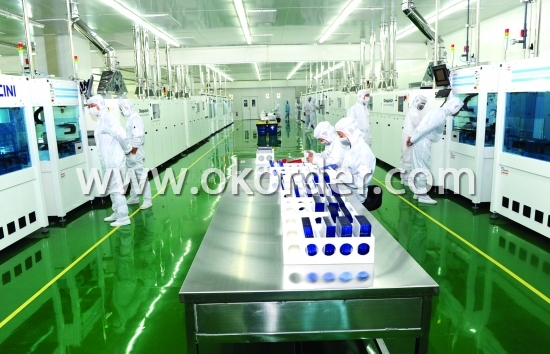
Package Picture of Poly Cells
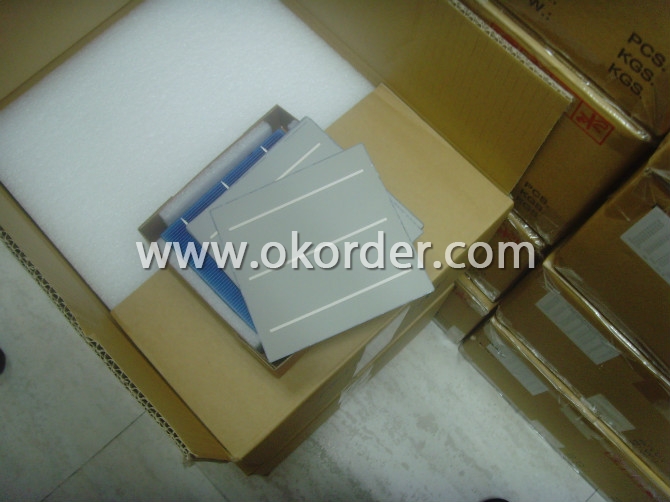
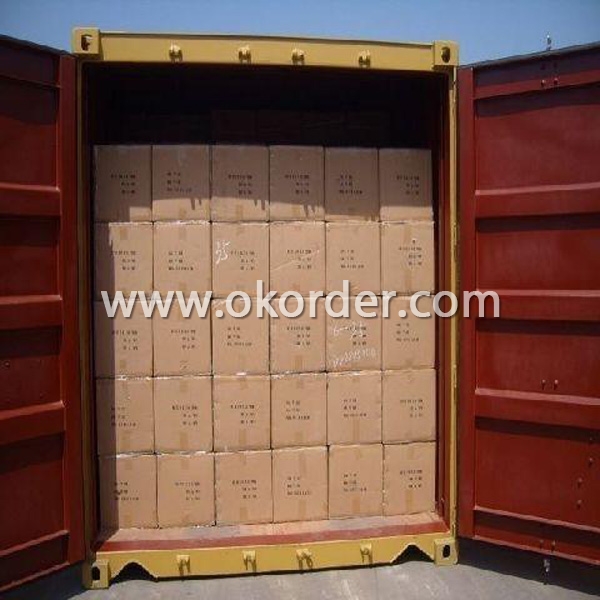
Polycrystalline solar cells 2BB/3BB combines the high conversion efficiency monocrystalline silicon cells and preparation of amorphous silicon thin film materials as well as long-life battery, etc. relatively simplified new generation of batteries, the conversion efficiency is generally about 12%, slightly lower than the silicon solar cells, there is no obvious efficiency recession, and may be prepared on an inexpensive substrate material, the cost is much lower than silicon cells, and more efficient than amorphous silicon thin film batteries.
From the production cost, than monocrystalline silicon solar cells cheaper, simple materials, saving power consumption, lower overall production costs, and therefore get a lot of development. In addition, Polycrystalline solar cells 2BB/3BB battery life is also shorter than the single crystal silicon solar cells.
Monocrystalline silicon solar cell production requires large amounts of high-purity silicon material and manufacturing process complexity of these materials, power consumption is large, the total production cost of solar cells has over one-half. Coupled with cylindrical silicon rods drawn, sliced wafer production of solar cell is composed of low solar plane component. Therefore, since the 1980s, some European and American developed countries put Polycrystalline solar cells 2BB/3BB.
Has been the focus of a single crystal to polycrystalline direction, mainly due to; [1] can supply less and less solar cell material end to end; [2] in terms of solar cell, a square substrate is more cost-effective, and by casting method polysilicon direct solidification method can be directly obtained rectangular materials; the production process [3] polysilicon continue to make progress, automatic casting furnace each production cycle (50 hours) can produce over 200 kg ingots, grain size reaches cm level; [4] Since the last decade of research and development of single-crystal silicon technology quickly, which technology has also been applied to the production of polycrystalline silicon cells, such as selective etching the emitter, back surface field, corrosion suede, surface and bulk passivation , thin metal gate electrode, using screen printing technology allows the width of the gate electrode is reduced to 50 m, height of 15 m or more, rapid thermal annealing technology for polysilicon production process can significantly shorten the time, single-chip thermal process time can be less than a minute to complete, using the technology in the 100 cm2 polycrystalline silicon sheet made cell conversion efficiency over 14%. According to reports, the 50 to 60 micron substrate made of polysilicon cell efficiency of over 16%. The use of mechanical groove, screen printing technology in 100 square centimeters crystal efficiency more than 17%, no mechanical groove in the same area on the efficiency of 16%, using buried gate structure, mechanical groove in the 130 cm2 polycrystalline on the cell efficiency reached 15.8%.
- Q: How much energy can a solar cell generate?
- A solar cell can generate varying amounts of energy depending on factors such as its size, efficiency, and the amount of sunlight it receives. On average, a standard solar cell can produce around 200 to 400 watts of power per square meter under ideal conditions. However, advancements in technology continue to increase the efficiency and output of solar cells, allowing for even greater energy generation in the future.
- Q: How are solar cells affected by temperature?
- Solar cells are negatively affected by high temperatures, as they can cause a decrease in efficiency and overall performance. The increase in temperature can lead to an increase in resistance, which reduces the flow of electric current within the cell. This decrease in current output results in a decrease in power generation. Additionally, high temperatures can accelerate the degradation of the materials used in solar cells, reducing their lifespan. However, low temperatures can have a positive effect on solar cell performance, as they can increase the efficiency and power output.
- Q: 24V 200W solar cells can charge 12V battery?
- 24-volt battery pack to 12-volt battery charge is possible, because the battery block resistance is large, allowing the output short-circuit.
- Q: Are there any books in the market t about solar cells and their applications?
- There are a lot of resources about solar cells on line, and they are cheaper.
- Q: How do solar cells perform in areas with limited space for installation?
- Solar cells can still perform effectively in areas with limited space for installation by utilizing innovative technologies such as rooftop solar panels, vertical solar panels, or solar panels integrated into building materials. These compact and space-efficient designs allow for the generation of solar energy even in tight spaces, making it possible to harness the benefits of solar power without requiring vast expanses of land.
- Q: What is the payback period for solar cells?
- The payback period for solar cells refers to the time it takes for the cost of installing solar panels to be recouped through energy savings. It typically ranges from 5 to 15 years, depending on factors such as the initial cost of installation, electricity usage, and available incentives or tax credits.
- Q: What is the impact of solar cells on wildlife?
- Solar cells have a minimal impact on wildlife as they do not produce any direct pollution or emissions that could harm animals. However, the installation of solar farms can disrupt natural habitats and affect local wildlife by altering the landscape and reducing available space for vegetation and animal species. Implementing proper planning and wildlife-friendly measures during the construction and operation of solar farms can help mitigate these potential impacts and create a more harmonious coexistence with wildlife.
- Q: How to generate solar cells, the principle of PN junction
- Solar energy is an inexhaustible renewable energy source for human beings, and it is clean energy and does not produce any environmental pollution. In the effective use of solar energy; solar energy photoelectric utilization is the fastest growing and most dynamic in recent years
- Q: How do solar cells perform in high-altitude locations?
- Solar cells perform well in high-altitude locations due to several factors. Firstly, at higher altitudes, there is often less air pollution and cloud cover, leading to more sunlight reaching the solar cells. Additionally, the thinner atmosphere at high altitudes allows for a higher concentration of solar radiation, resulting in increased energy generation. Finally, the cooler temperatures at higher altitudes can actually improve the efficiency of solar cells, as they tend to perform better in lower temperatures. Overall, solar cells are highly effective in high-altitude locations, making them an ideal renewable energy solution in such areas.
- Q: Can solar cells be used in wearable technology?
- Yes, solar cells can be used in wearable technology. They can be integrated into clothing, accessories, or even directly into the design of wearable devices to harness solar energy and power them. This allows for increased portability and sustainability as wearable technology can be charged on-the-go using solar power.
1. Manufacturer Overview
| Location | Zhejiang, China |
| Year Established | 2008 |
| Annual Output Value | Above US$ 320 Million |
| Main Markets | Australia; Asia; South East Asia; South America; North America; Europe; Africa |
| Company Certifications | ISO 9001:2008; CE; TUV; UL |
2. Manufacturer Certificates
| a) Certification Name | |
| Range | |
| Reference | |
| Validity Period |
3. Manufacturer Capability
| a) Trade Capacity | |
| Nearest Port | Ningbo, China |
| Export Percentage | 45% - 50% |
| No.of Employees in Trade Department | 200-300 People |
| Language Spoken: | English; Chinese |
| b) Factory Information | |
| Factory Size: | Above 10,000 Square meter |
| No. of Production Lines | 8 |
| Contract Manufacturing | OEM Service Offered; Design Service Offered |
| Product Price Range | Average |
Send your message to us
Polycrystalline Solar Cells 2BB/3BB with Long-term Electrical Stability
- Loading Port:
- Tianjin
- Payment Terms:
- TT or LC
- Min Order Qty:
- 4200 watt
- Supply Capability:
- 600000 watt/month
OKorder Service Pledge
OKorder Financial Service
Similar products
Hot products
Hot Searches
Related keywords
